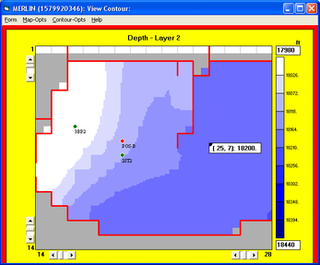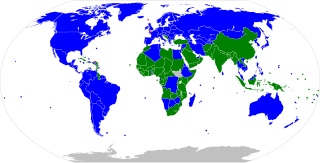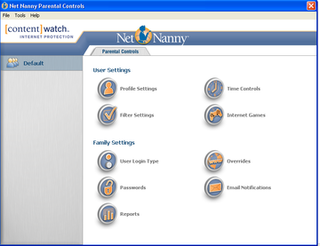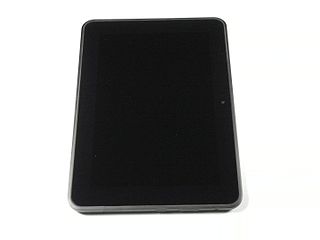
Microsoft Office, or simply Office, is a family of client software, server software, and services developed by Microsoft. It was first announced by Bill Gates on August 1, 1988, at COMDEX in Las Vegas. Initially a marketing term for an office suite, the first version of Office contained Microsoft Word, Microsoft Excel, and Microsoft PowerPoint. Over the years, Office applications have grown substantially closer with shared features such as a common spell checker, OLE data integration and Visual Basic for Applications scripting language. Microsoft also positions Office as a development platform for line-of-business software under the Office Business Applications brand. On July 10, 2012, Softpedia reported that Office was being used by over a billion people worldwide.

Structural geology is the study of the three-dimensional distribution of rock units with respect to their deformational histories. The primary goal of structural geology is to use measurements of present-day rock geometries to uncover information about the history of deformation (strain) in the rocks, and ultimately, to understand the stress field that resulted in the observed strain and geometries. This understanding of the dynamics of the stress field can be linked to important events in the geologic past; a common goal is to understand the structural evolution of a particular area with respect to regionally widespread patterns of rock deformation due to plate tectonics.
Geomechanics involves the study of the mechanics of soil and rock.

A tablet computer, commonly shortened to tablet, is a mobile device, typically with a mobile operating system and touchscreen display processing circuitry, and a rechargeable battery in a single, thin and flat package. Tablets, being computers, do what other personal computers do, but lack some input/output (I/O) abilities that others have. Modern tablets largely resemble modern smartphones, the only differences being that tablets are relatively larger than smartphones, with screens 7 inches (18 cm) or larger, measured diagonally, and may not support access to a cellular network.

Clip Studio Paint, informally known in Japan as Kurisuta (クリスタ), is a family of software applications developed by Japanese graphics software company Celsys. It is used for the digital creation of comics, general illustration, and 2D animation. Clip Studio is a companion program for managing and sharing digital assets, bundled with Clip Studio Paint. The software is available in versions for macOS, Windows, iOS, iPadOS, Android, and Chrome OS.

Reservoir simulation is an area of reservoir engineering in which computer models are used to predict the flow of fluids through porous media.

A fracture is any separation in a geologic formation, such as a joint or a fault that divides the rock into two or more pieces. A fracture will sometimes form a deep fissure or crevice in the rock. Fractures are commonly caused by stress exceeding the rock strength, causing the rock to lose cohesion along its weakest plane. Fractures can provide permeability for fluid movement, such as water or hydrocarbons. Highly fractured rocks can make good aquifers or hydrocarbon reservoirs, since they may possess both significant permeability and fracture porosity.
Petrel is a software platform used in the exploration and production sector of the petroleum industry. It allows the user to interpret seismic data, perform well correlation, build reservoir models, visualize reservoir simulation results, calculate volumes, produce maps and design development strategies to maximize reservoir exploitation. Risk and uncertainty can be assessed throughout the life of the reservoir. Petrel is developed and built by Schlumberger.

The usage share of operating systems is the percentage of computing devices that run each operating system (OS) at any particular time. All such figures are necessarily estimates because data about operating system share is difficult to obtain; there are few reliable primary sources – and no agreed methodologies for its collection.

Android is a mobile operating system based on a modified version of the Linux kernel and other open source software, designed primarily for touchscreen mobile devices such as smartphones and tablets. Android is developed by a consortium of developers known as the Open Handset Alliance and commercially sponsored by Google. It was unveiled in November 2007, with the first commercial Android device launched in September 2008.
A mobile operating system is an operating system for mobile phones, tablets, smartwatches, 2-in-1 PCs, smart speaker, or other mobile devices. While computers such as typical laptops are 'mobile', the operating systems used on them are generally not considered mobile ones, as they were originally designed for desktop computers that historically did not have or need specific mobile features. This distinction is becoming blurred in some newer operating systems that are hybrids made for both uses.

Net Nanny is a content-control software suite marketed primarily towards parents as a way to monitor and control their child's computer and phone activity.
The TaskForceMajella (TFM) is an industry-funded geoscientific research project conducted between the years 1998 and 2005. The project involved numerous universities distributed worldwide, and was sponsored by a number of international major oil companies. The area of research was the Majella Mountain in Central Italy, regarded as an analogue of a faulted and fractured hydrocarbon reservoir as can be found in major provinces like the Middle East, Caspian Basin, Mediterranean Basin, and other areas. The scope was to obtain knowledge on the relation between fracture and fault generation, and all types of geological aspects of the evolution of the geological structure.

BIMx is a set of desktop and mobile software tools to interactively present the 3D model and 2D documentation of Building Information Models created with ArchiCAD through a much simpler and intuitive interface than ArchiCAD's complex BIM authoring environment's UI. 3D models with 2D drawing sheets exported to BIMx document format can be viewed with native viewer applications developed for Apple iOS, Android, Mac OS X, and Microsoft Windows operating systems. BIMx presents three dimensional building models in an interactive way similar to First-person shooter video games. Clients, consultants and builders can virtually walk through and make measurements in the 3D model without the need for installing ArchiCAD. The real-time cutaway function can help to discover the construction details of the displayed building model. 2D construction documentation can be accessed directly from the BIMx Hyper-model's 3D model views providing more detailed information about the building.

The Fire HD, also known as Kindle Fire HD, is a member of the Amazon Fire family of tablet computers. The eight generation family consists of: 7", 8.9", 7", 6" & 7", 8" & 10.1", 8", 8" & 10.1", 8" and 10.1". These devices run the Fire OS operating system.

Amazon Fire OS is a mobile operating system based on Android and created by Amazon for its Fire Phone and Fire brand of tablets, Echo, and other content delivery devices like Fire TV. It is forked from the open source Android operating system and includes proprietary software, a customized user interface primarily centered on content consumption, and heavy ties to content available from Amazon's own storefronts and services.
David D. Pollard is a professor in geomechanics and structural geology at Stanford University.

Windows 10 Mobile is a discontinued mobile operating system developed by Microsoft. First released in 2015, it is a successor to Windows Phone 8.1, but was marketed by Microsoft as being an edition of its PC operating system Windows 10.

HERE WeGo is a web mapping and navigation service, operated by Here Technologies. Originally developed by Nokia as HERE Maps, the mapping software application was first released for Windows Phone and the World Wide Web in 2013 as a revamped version of Nokia Maps. The Here Maps application was then released for the Android platform on 10 December 2014 and later for iOS on 11 March 2015, and the name was changed to Here WeGo in July 2016. It is also the default maps service provider for the Amazon Fire tablets and smartphone.

In geology, 3D fold evolution is the study of the full three dimensional structure of a fold as it changes in time. A fold is a common three-dimensional geological structure that is associated with strain deformation under stress. Fold evolution in three dimensions can be broadly divided into two stages, namely fold growth and fold linkage. The evolution depends on fold kinematics, causes of folding, as well as alignment and interaction of the each structure with respect to each other. There are several ways to reconstruct the evolution progress of folds, notably by using depositional evidence, geomorphological evidence and balanced restoration. Understanding the evolution of folds is important because it helps petroleum geologists to gain a better understanding on the distribution of structural traps of hydrocarbon.














